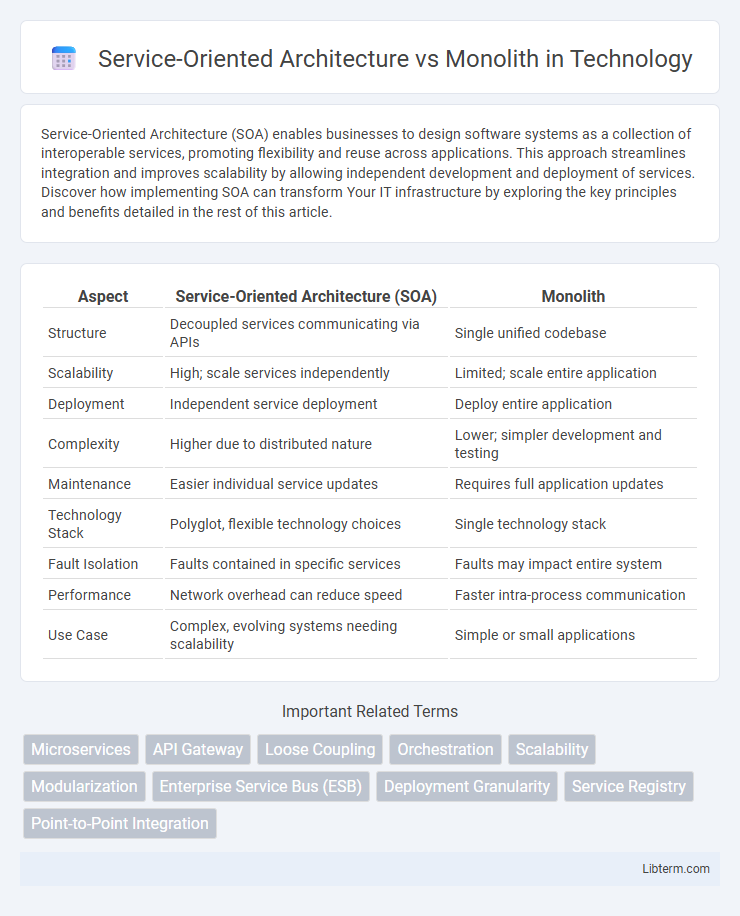Service-Oriented Architecture (SOA) enables businesses to design software systems as a collection of interoperable services, promoting flexibility and reuse across applications. This approach streamlines integration and improves scalability by allowing independent development and deployment of services. Discover how implementing SOA can transform Your IT infrastructure by exploring the key principles and benefits detailed in the rest of this article.
Table of Comparison
| Aspect | Service-Oriented Architecture (SOA) | Monolith |
|---|---|---|
| Structure | Decoupled services communicating via APIs | Single unified codebase |
| Scalability | High; scale services independently | Limited; scale entire application |
| Deployment | Independent service deployment | Deploy entire application |
| Complexity | Higher due to distributed nature | Lower; simpler development and testing |
| Maintenance | Easier individual service updates | Requires full application updates |
| Technology Stack | Polyglot, flexible technology choices | Single technology stack |
| Fault Isolation | Faults contained in specific services | Faults may impact entire system |
| Performance | Network overhead can reduce speed | Faster intra-process communication |
| Use Case | Complex, evolving systems needing scalability | Simple or small applications |
Introduction to Software Architecture Models
Service-Oriented Architecture (SOA) organizes software as a collection of interoperable services, enabling scalability and flexibility through distributed components. In contrast, the Monolith model consolidates all functionalities into a single, unified codebase, often simplifying development but limiting modularity and scalability. Understanding these foundational software architecture models helps optimize system design for performance, maintainability, and deployment strategies.
What is Monolithic Architecture?
Monolithic architecture is a traditional software design model where all components and functionalities are integrated into a single, unified codebase. This approach simplifies deployment but can lead to challenges in scalability, maintenance, and flexibility as application complexity grows. Organizations often face slower development cycles and difficulty in adopting new technologies due to tight coupling within a monolithic system.
Key Features of Service-Oriented Architecture (SOA)
Service-Oriented Architecture (SOA) features modularity, where independent services communicate through well-defined interfaces using protocols like SOAP or REST, enabling scalability and flexibility. SOA emphasizes loose coupling, allowing services to be updated, replaced, or deployed independently without impacting the entire system. Key benefits include increased reusability, improved integration across heterogeneous platforms, and enhanced maintainability compared to monolithic architectures.
Core Differences Between Monolith and SOA
Service-Oriented Architecture (SOA) divides applications into loosely coupled, reusable services communicating over a network, improving scalability and flexibility, whereas monolithic architecture consolidates all functionalities into a single, tightly integrated codebase. SOA enables independent deployment and enhances maintainability by decoupling services, while monoliths often face challenges with scalability, updating, and fault isolation due to their interconnected structure. The core difference lies in SOA's modular approach promoting distributed development versus monolith's unified design prioritizing simplicity but limiting evolution.
Scalability: SOA vs Monolithic Applications
Service-Oriented Architecture (SOA) inherently enhances scalability by decomposing applications into independent, loosely coupled services that can be scaled individually based on demand. Monolithic applications, by contrast, face significant challenges in scaling since the entire system must be scaled as a single unit, leading to inefficient resource utilization and increased costs. SOA's distributed nature allows for parallel development and deployment, facilitating horizontal scaling and better fault isolation compared to monolithic architectures.
Ease of Maintenance and Updates
Service-Oriented Architecture (SOA) enables easier maintenance and updates by isolating services, allowing independent modifications without affecting the entire system. Monolithic architectures require extensive regression testing and deployment of the whole application for updates, increasing downtime and complexity. SOA's modular nature reduces risk and accelerates the delivery of new features through continuous integration and deployment pipelines.
Performance Comparison: Monolith vs SOA
Monolithic architectures often deliver higher performance due to tightly integrated components minimizing inter-process communication overhead. Service-Oriented Architecture (SOA) may introduce latency from network calls and service orchestration, impacting response times under heavy load. Scalability advantages of SOA allow independent services to be optimized and scaled selectively, potentially improving overall system throughput compared to monoliths constrained by unified scaling.
Security Considerations in SOA and Monolithic Designs
Service-Oriented Architecture (SOA) enhances security by isolating services, enabling granular access control, and limiting the attack surface through well-defined interfaces and protocols such as OAuth and TLS. Monolithic designs often face higher security risks due to tightly coupled components, making vulnerability containment and patching more complex across the entire application. Implementing secure communication, authentication, and authorization mechanisms in SOA reduces risks of lateral movement and data breaches compared to monolithic systems.
Real-World Use Cases and Examples
Service-Oriented Architecture (SOA) enables organizations like Amazon and Netflix to scale complex applications by decomposing them into loosely coupled services, improving flexibility and fault isolation in real-world use cases. Monolithic architectures, such as traditional ERP systems used by many enterprises, offer simplicity and ease of deployment but often struggle with scalability and rapid feature updates. In practice, companies transitioning from monoliths to SOA, like Walmart, have experienced enhanced agility and improved system resilience through service decoupling and distributed deployment.
Choosing the Right Architecture for Your Project
Choosing the right architecture for your project depends on factors like scalability, development speed, and team size. Service-Oriented Architecture (SOA) offers modularity, easier maintenance, and flexibility by breaking applications into independent services, ideal for large, complex projects requiring frequent updates. Monolithic architecture suits smaller teams or projects with simpler requirements by providing easier deployment and straightforward development but may face challenges in scaling and maintaining over time.
Service-Oriented Architecture Infographic

 libterm.com
libterm.com